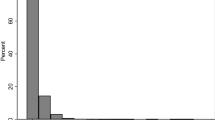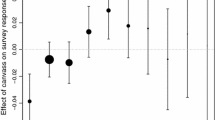Abstract
How confident can we be that the comparatively low response rates associated with mail surveys of groups of political activists, such as participants of a demonstration, does not hide a substantial nonresponse bias? The paper compares the results of a face-to-face survey of 2003 anti-Iraq war demonstrators in Glasgow, achieving a near perfect response rate, with the data derived from a mail survey handed out to demonstrators eliciting valid responses from 37% of marchers. The comparison shows that better educated, older, female demonstrators were more likely to return the mail questionnaire. Also demonstrators having born a higher ‘cost’ of travelling to the demonstration are more likely to respond. There was no evidence that political interest or political orientation played an important role. However, those who had taken part in demonstrations very frequently in recent years were less likely to return the mail questionnaire. While these results provide some reassurance that even with response rates below 40%, no substantive political bias is present, researchers undertaking surveys of activists should be alerted to the need to address possible nonresponse biases in a systematic way.
Similar content being viewed by others
References
Dillman D.A.: Mail and Internet Surveys. The Tailored Design Method, 2nd edn. Wiley, New York (2000)
Goudy W.J.: Nonresponse effects on relationships between variables. Public Opin. Q. 40, 360–369 (1976)
Groves R.M., Singer E., Corning A.: Leverage-saliency theory of survey participation. Description and illustration. Public Opin. Q. 64, 299–308 (2000)
Groves R.M., Presser S., Dipko S.: The role of topic interest in survey participation decisions. Public Opin. Q. 68, 2–31 (2004)
Kaplowitz M.D., Hadlock T.D., Levine R.: A comparison of web and mail survey response rates. Public Opin. Q. 68, 94–101 (2004)
Klandermans B., Oegema D.: Potentials, networks, motivation and barriers: steps towards participation in social movements. Am. Sociol. Rev. 52, 519–531 (1987)
Kornhauser W.: The Politics of Mass Society. Routledge and Kegan Paul, London (1960)
Kriesi H.: The rebellion of the research objects. In: Diani, M., Eyerman, R.(eds) Studying Collective Action, pp. 194–216. Sage, London (1982)
Leslie L.I.: Are high response rates essential to valid surveys? Soc. Sci. Res. 1, 323–334 (1972)
Lin N.: The McIntire march: a study of recruitment and commitment. Public Opin. Q. 38, 562–573 (1974–1975)
Meyer D.S.: The Politics of Protest: Social Movements in America. Oxford University Press, New York (2007)
Moore D.L., Tarnai J.: Evaluating nonresponse error in mail surveys. In: Groves, R.M., Dillman, D.A., Eltinge, J.L., Little, R.J.A.(eds) Survey Nonresponse, pp. 197–211. Wiley, New York (2002)
Norris P., Walgrave S., Van Aelst P.: Who demonstrates? Antistate rebels, conventional participants, or everyone?. Comp. Polit. 37, 189–205 (2005)
Pattie C., Seyd P., Whiteley P.: Citizenship in Britain: Values, Participation and Democracy. Cambridge University Press, Cambridge (2004)
Porter S.R., Whitcomb M.E.: Non-response in student surveys: the role of demographics, engagement and personality. Res. High. Educ. 46, 127–152 (2005)
Rogelberg S.G., Conway J.M., Sederburg M.E., Spitzmüller C., Aziz S., Knight W.E.: Profiling active and passive nonrespondents to an organizational survey. J. Appl. Psychol. 88, 1104–1114 (2003)
Seidler J., Meyer K., Gillivray L.M.: Collecting data on crowds and rallies: a new method of stationary sampling. Soc. Forces 55, 507–519 (1976)
Van Aelst P., Walgrave S.: Who is that (wo)man in the street? From the normalisation of protest to the normalisation of the protester. Eur. J. Polit. Res. 39, 461–486 (2001)
Author information
Authors and Affiliations
Corresponding author
Rights and permissions
About this article
Cite this article
Rüdig, W. Assessing nonresponse bias in activist surveys. Qual Quant 44, 173–180 (2010). https://doi.org/10.1007/s11135-008-9184-9
Published:
Issue Date:
DOI: https://doi.org/10.1007/s11135-008-9184-9




